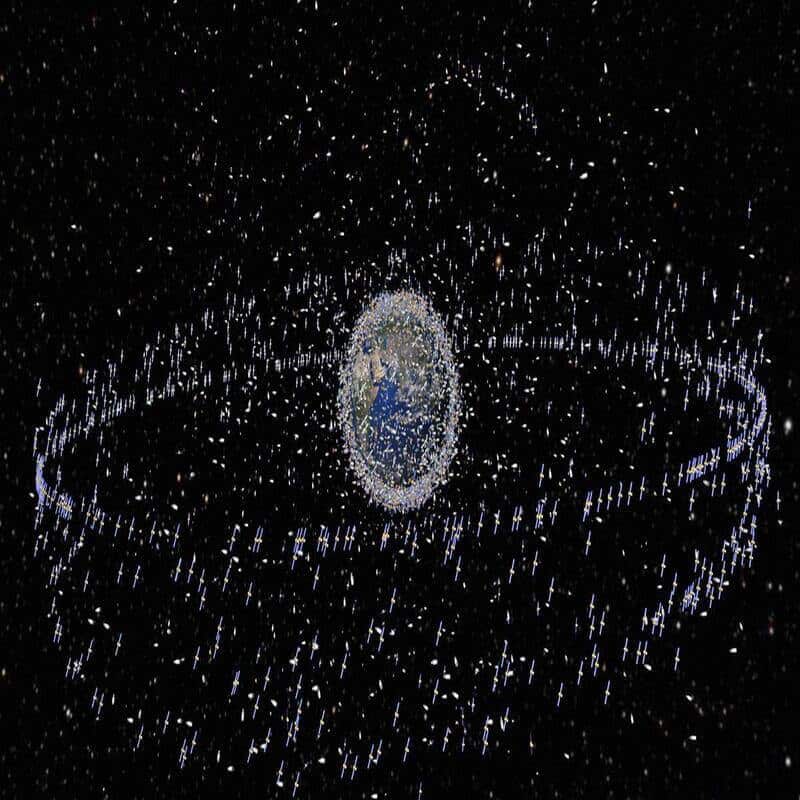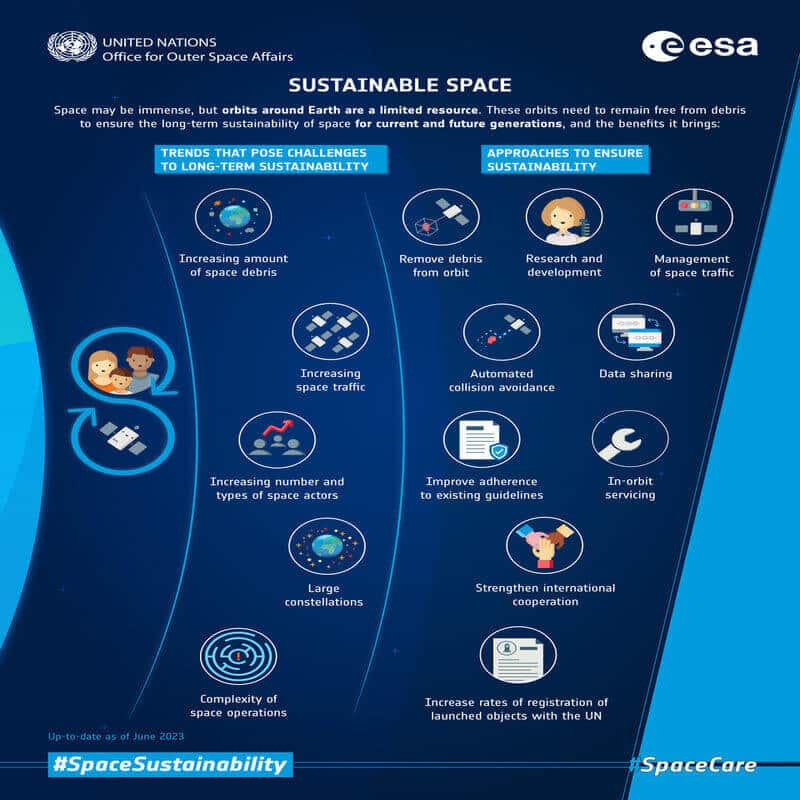
Achieving zero orbital debris means having no space debris or space junk, which is a significant challenge but is critical for the sustainability of future space activities. Read here to learn more.
Orbital debris or Space debris consists of defunct satellites, spent rocket stages, and fragments from disintegration, erosion, and collisions.
As space activities have increased, so has the number of debris, which poses a risk to operational satellites, the International Space Station (ISS), and future space missions.
The concept of zero orbital debris is centred on preventing the creation of new debris and actively removing existing debris from orbit.
Zero orbital debris
Space debris is defined as “All non-functional, human-made objects, including no longer functioning spacecraft or fragments of them, in orbit or reentering Earth’s atmosphere.”
How much debris is it OK to create? Ideally, zero debris.
Strategies for Achieving Zero Orbital Debris

Mitigation Measures:
- Launch Phase Reduction: Implementing measures to reduce debris during the launch and operational phases of satellites and rockets. This includes designing launchers and satellites to minimize the release of debris.
- Post-Mission Disposal: Ensuring that satellites and upper stages of rockets are deorbited at the end of their operational life. For geostationary satellites, this often means moving them to a “graveyard orbit,” while low Earth orbit (LEO) satellites can be deorbited to burn up in the Earth’s atmosphere.
- Passivation: Emptying fuel tanks and releasing energy stored in batteries or other components to prevent explosions that could create additional debris.
Active Debris Removal (ADR):
- Robotic Systems: Developing and deploying robotic systems or satellites equipped with nets, harpoons, or robotic arms to capture and deorbit large debris objects.
- Laser Systems: Investigating the use of ground-based or space-based lasers to alter the trajectory of debris, lowering their orbit to hasten atmospheric re-entry and burn-up.
- Electrodynamic Tethers: Exploring the use of electrodynamic tethers attached to debris to accelerate its deorbit by interacting with the Earth’s magnetic field.
International Collaboration and Regulation:
- Global Standards: Promoting international cooperation to establish and enforce global standards for satellite design, operation, and end-of-life disposal to prevent the creation of new debris.
- Space Traffic Management: Developing comprehensive space traffic management systems to track and manage the movements of satellites and debris, reducing the risk of collisions.
- Legal and Economic Incentives: Implementing legal frameworks and economic incentives, such as levies or insurance schemes, to encourage adherence to best practices in debris mitigation and support efforts for active debris removal.
Challenges to Achieving Zero Orbital Debris
- Technical and Financial: The development and deployment of effective debris removal technologies are technically challenging and expensive. There is also the question of who should bear the cost, especially for removing debris that has been in orbit for decades.
- Legal and Political: Space is governed by international treaties and agreements that were not designed with debris removal in mind. Establishing a legal framework for active debris removal poses significant challenges, including liability issues in case of accidents.
- International Cooperation: Given the global nature of space activities and space debris, international cooperation is essential. However, geopolitical tensions can hinder collaborative efforts to address the problem.
Global efforts

European Space agency
As part of the Zero Debris approach, ESA has updated its debris mitigation requirements and standards that will govern how the Agency’s missions are designed, built, flown and disposed of, but also setting the rules for any company or institution that works with ESA on its missions.
A study put forward eight recommendations to reach Zero Debris by 2030, which form the foundation of the recently published ‘ESA Space Debris Mitigation Requirements’.
1) Guarantee successful disposal
- Ensuring the safe disposal of space objects is of utmost importance. ‘Self disposal’ through atmospheric reentry or orbiting to a safe altitude should be verified in advance of a mission’s launch, with a probability of success higher than a certain minimum threshold (currently set at 90%).
2) Improve orbital clearance
- By reducing the time an object is in orbit, the smaller the chance that it will collide with another object and create further debris.
3) Avoid in-orbit collisions
- Collision avoidance – manoeuvring a satellite out of the way of potential collision – is now a regular part of flying missions in low-Earth orbit. It comes at a cost as fuel is required and instruments are often turned off, meaning data is lost.
4) Avoid internal break-ups
- Enhanced health monitoring and robust passivation techniques should be implemented to prevent satellites from breaking up from within, caused by system explosions from leftover fuel or energy from solar panels.
5) Prevent the intentional release of space debris
- Recommendations emphasise that the intentional release of any ‘Mission Related Object’ – such as protective covers, lens caps, or rocket fairings – should be avoided to prevent further debris growth.
6) Improve on-ground casualty risk assessment
- Standardised tools and methodologies should be developed for assessing the casualty risk, on the ground, of reentering objects, as well as for verifying assessments of how a mission will demise.
7) Guarantee Dark and Quiet skies
- Measures should be identified and implemented to minimise the impact of space objects on optical and infrared astronomy, as well as radio astronomy, to maintain dark and quiet skies.
8) Beyond the protected regions
- Other orbits, such as those used by Global Navigation Satellite System (GNSS) constellations and lunar orbits, should also be considered and protected to ensure their long-term sustainability.
- Adapted Zero Debris recommendations should be formulated and applied beyond low-Earth orbit and Geostationary orbit.
NASA
- The NASA Orbital Debris Program officially began in 1979 in the Space Sciences Branch at the Johnson Space Center (JSC) in Houston, Texas.
- The program looks for ways to create less orbital debris and designs equipment to track and remove the debris already in space.
Why in the news?
PSLV accomplishes zero orbital debris mission:
- Another milestone was achieved by ISRO on March 21, 2024, when the PSLV Orbital Experimental Module-3 (POEM-3) met its fiery end through a re-entry into the Earth’s atmosphere.
- The PSLV-C58/XPoSat mission has practically left zero debris in orbit.
- After it completed the primary mission of injecting all satellites into their target orbits, the fourth stage of the PSLV was transformed into the POEM-3.
- It was subsequently de-orbited from 650 kilometres to 350 kilometres, rendering it more susceptible to being pulled towards the earth and burning up in the atmosphere.
- It “passivated the stage,” meaning dumped its fuel, to avoid an explosion that could have flung small pieces of debris into orbit.
May 2024: Twelve nations have signed the Zero Debris Charter at the European Space Agency (ESA) /EU Space Council, solidifying their commitment to the long-term sustainability of human activities in Earth orbit.
- Unveiled at the ESA Space Summit in Seville in November 2023, the Zero Debris Charter aims to achieve debris-neutrality in space by 2030.
Way forward
ISRO will continue its commitment to providing a cost-effective orbital experiment platform.
- The growing menace due to space debris, especially with multiple small satellite constellations coming up, poses a significant threat to space activities, including satellite launches, human spaceflight, and space exploration missions.
- ISRO, being a responsible space agency, is committed to mitigating this threat through the development and implementation of advanced debris tracking systems, space-object deorbiting technologies, and responsible satellite deployment practices, thus safeguarding orbital environments for present and future space endeavours.
Conclusion
Achieving zero orbital debris is a complex but essential goal for ensuring the long-term sustainability of space activities.
It requires a multifaceted approach combining technology, international law, and global cooperation.
While the challenges are significant, the increasing recognition of the risks posed by space debris is driving efforts to find effective solutions.
-Article by Swathi Satish





Leave a Reply